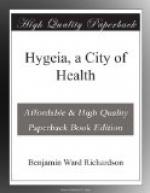As with the bricks, so with the mortar and the wood employed in building, they are rendered, as far as possible, free of moisture. Sea sand containing salt, and wood that has been saturated with sea water, two common commodities in badly built houses, find no place in our modern city.
The most radical changes in the houses of our city are in the chimneys, the roofs, the kitchens, and their adjoining offices. The chimneys, arranged after the manner proposed by Mr. Spencer Wells, are all connected with central shafts, into which the smoke is drawn, and, after being passed through a gas furnace to destroy the free carbon, is discharged colourless into the open air. The city, therefore, at the expense of a small smoke rate, is free of raised chimneys and of the intolerable nuisance of smoke. The roofs of the houses are but slightly arched, and are indeed all but flat. They are covered either with asphalte, which experience, out of our supposed city, has proved to last long and to be easily repaired, or with flat tile. The roofs, barricaded round with iron palisades, tastefully painted, make excellent outdoor grounds for every house. In some instances flowers are cultivated on them.
The housewife must not be shocked when she hears that the kitchens of our model city, and all the kitchen offices, are immediately beneath these garden roofs; are, in fact, in the upper floor of the house instead of the lower. In every point of view, sanitary and economical, this arrangement succeeds admirably. The kitchen is lighted to perfection, so that all uncleanliness is at once detected. The smell which arises from cooking is never disseminated through the rooms of the house. In conveying the cooked food from the kitchen, in houses where there is no




